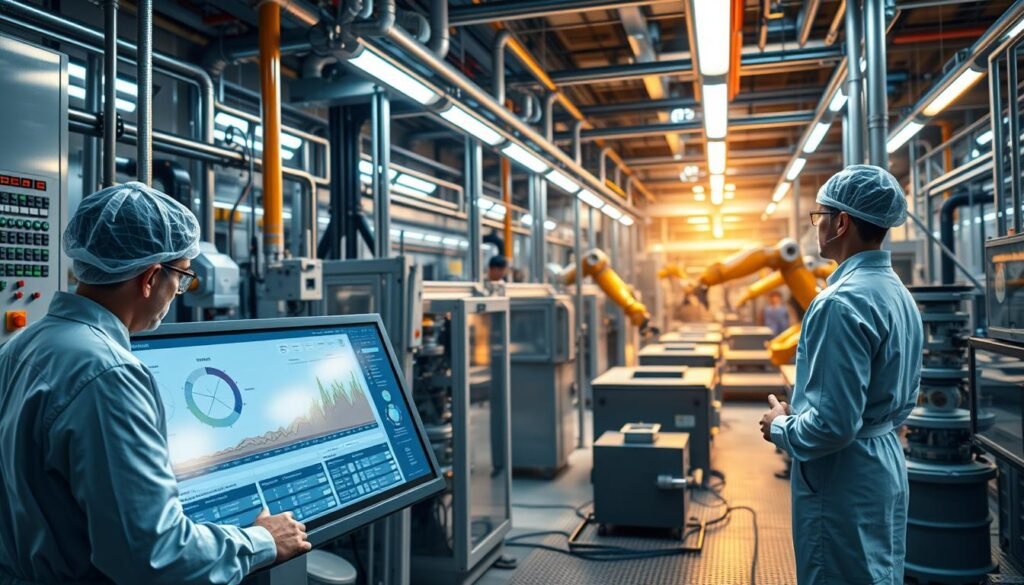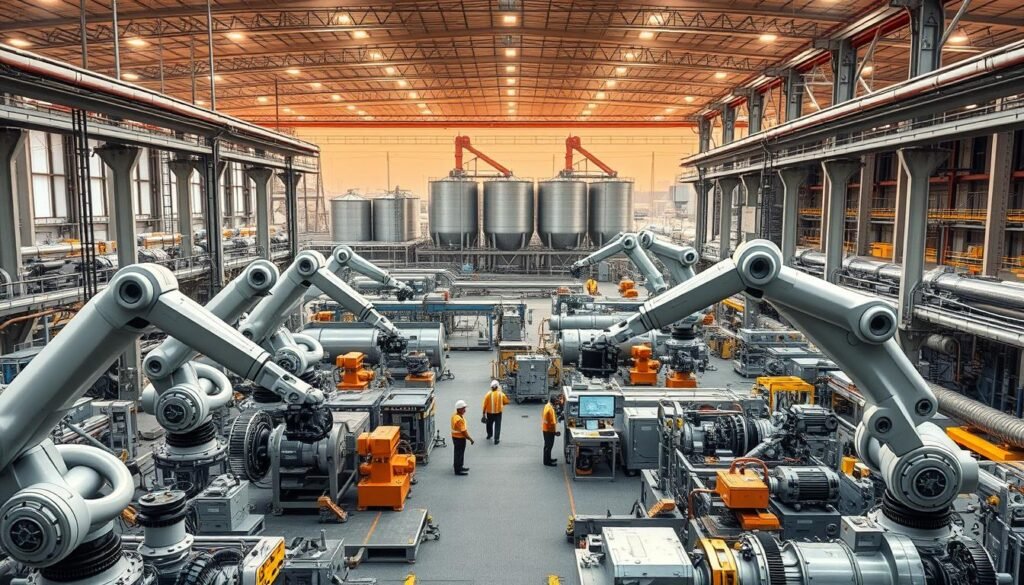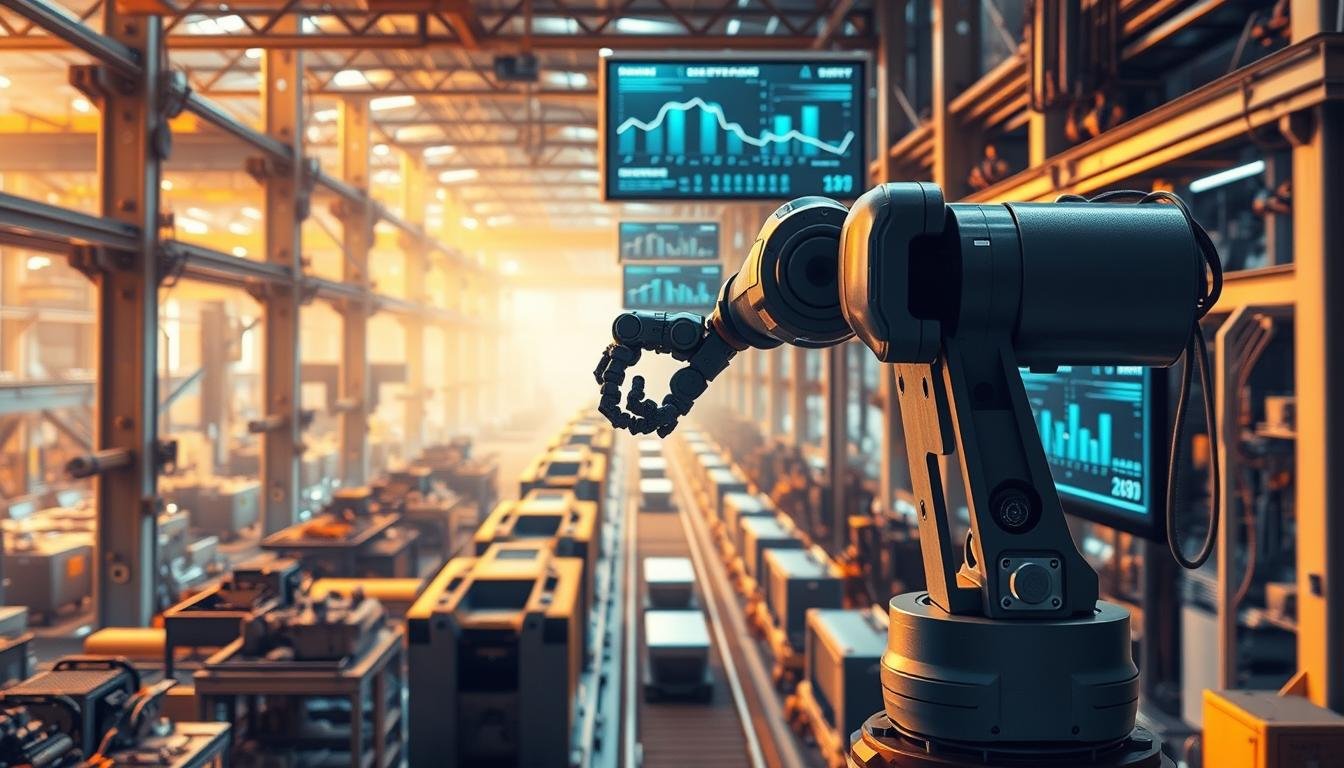Table of Contents
Have you ever wondered how technology is reshaping the way we manufacture products? The answer lies in the transformative power of machine learning and advanced algorithms. These innovations are redefining the industry, making processes smarter, faster, and more efficient.
From self-learning robots to real-time data analysis, the future of manufacturing is here. Sensors and edge computing solutions are enabling companies to monitor equipment and predict maintenance needs before issues arise. This not only reduces downtime but also enhances productivity and quality.
As we move from rigid programming to adaptive systems, the benefits are clear. Companies are leveraging these advancements to stay competitive in a rapidly evolving environment. The integration of technology is not just a trend; it’s a necessity for growth.
In this article, we’ll explore how these innovations are driving change and what it means for the future of production. Let’s dive into the key elements that are unlocking new possibilities in the industry.
Key Takeaways
- Self-learning robots and cobots are transforming manufacturing processes.
- Real-time data analysis via sensors enhances efficiency and reduces downtime.
- Predictive maintenance minimizes equipment failures and boosts productivity.
- Adaptive systems replace rigid programming, offering greater flexibility.
- Integration of advanced algorithms improves product quality and performance.
Understanding the Role of artificial intelligence in industrial automation
Modern production systems are undergoing a significant transformation. The integration of advanced technologies is reshaping how industries operate, making processes smarter and more efficient. From real-time monitoring to predictive maintenance, these innovations are driving a new era of productivity.
Overview of Industrial Automation Trends
One of the most notable trends is the use of sensors for real-time condition monitoring. These devices collect data continuously, enabling companies to detect issues before they escalate. This approach not only reduces downtime but also enhances efficiency across the board.
Another key trend is the move toward autonomous production. By leveraging machine learning algorithms, manufacturers can automate complex tasks with minimal human intervention. This shift is paving the way for smarter, more adaptive systems.
The Evolution of Advanced Systems in Manufacturing
Traditional programming methods are being replaced by self-learning algorithms. These systems can analyze vast amounts of data to optimize processes and improve quality. For example, predictive maintenance models use historical data to forecast equipment failures, reducing costs and improving reliability.
Companies are also adopting collaborative robots, or cobots, to streamline operations. These robots work alongside humans, enhancing productivity while ensuring safety. The combination of advanced technologies and data-driven insights is creating a foundation for future advancements in industrial control systems.
Implementing Machine Learning for Process Optimization
The future of manufacturing is being shaped by innovative technologies. Among these, machine learning stands out as a game-changer. It’s transforming how we approach processes, making them smarter and more efficient.

Self-Learning Robots and Cobots
Self-learning robots are redefining the industry. These machines adapt their operations using real-time sensor inputs and advanced algorithms. They can handle complex tasks with minimal human intervention, boosting efficiency and quality.
Collaborative robots, or cobots, are another breakthrough. They work alongside humans, enhancing productivity while ensuring safety. This synergy between technology and human expertise is paving the way for smarter production environments.
Strategies for Predictive Maintenance and Process Control
Predictive maintenance is a key strategy in modern manufacturing. By analyzing historical datum, companies can forecast equipment failures before they occur. This approach reduces downtime and lowers costs significantly.
Advanced models use supervised and unsupervised learning to optimize operations. For example, real-time analysis of sensor data helps detect anomalies early. This ensures smoother process control and better product outcomes.
These strategies not only improve efficiency but also create safer and more resilient environments. By leveraging machine learning, we’re unlocking new possibilities for growth and innovation.
Enhancing Productivity with AI-Enabled Tools and Techniques
Innovative tools are reshaping how we approach complex tasks in modern industries. Among these, AI-enabled smart glasses and augmented reality (AR) are making a significant impact. These technologies are transforming the way we handle maintenance, production, and even remote troubleshooting.
Leveraging Smart Glasses and Augmented Reality
Smart glasses powered by machine learning are changing the game. They overlay critical process data directly into the user’s field of view. This hands-free approach enhances efficiency and reduces errors during complex tasks.
AR integrates seamlessly with sensor data to provide real-time analysis. For example, technicians can access step-by-step instructions while repairing equipment. This not only speeds up maintenance but also ensures higher quality outcomes.
Another advantage is remote expert assistance. Using AR, off-site specialists can guide on-site workers through complex operations. This reduces downtime and ensures tasks are completed correctly the first time.
These tools also improve task management. Workers can access information without interrupting their workflow. This leads to smoother production cycles and better control over operations.
By combining AR with technology, we’re creating safer and more productive environments. These innovations are not just about automation; they’re about empowering workers to achieve more.
Real-World Applications and Use Cases in Industry
The practical impact of advanced systems is evident across various industries. From bottling lines to assembly processes, these technologies are driving efficiency and innovation. Let’s explore how real-world applications are transforming the way we work.

Case Studies: Bottling Lines and Assembly Processes
In the beverage industry, bottling lines have seen significant improvements. Machine learning algorithms analyze sensor data to optimize filling processes. This ensures consistent quality and reduces waste.
Assembly processes in automotive manufacturing have also benefited. Companies like Ford use robots to streamline tasks. These machines work alongside humans, enhancing production speed and accuracy.
Condition Monitoring and Edge Computing Benefits
Condition monitoring is another area where technology shines. By using sensors, companies can detect anomalies in real-time. This proactive approach minimizes downtime and extends equipment life.
Edge computing plays a crucial role here. It processes datum on-site, eliminating network delays. This ensures faster response times and smoother operations.
For example, BMW uses edge computing to monitor assembly lines. This allows them to predict maintenance needs and avoid costly breakdowns.
These applications not only improve efficiency but also set a standard for future advancements. By leveraging these tools, we’re creating smarter, more resilient environments.
Adopting a Scalable and Secure AI Ecosystem
Building a future-ready ecosystem requires a blend of advanced technology and strategic planning. As industries evolve, the need for secure and scalable solutions becomes critical. A robust AI ecosystem ensures long-term success by integrating intelligent sensors with powerful data platforms.
Integrating Intelligent Sensors and Data Platforms
Intelligent sensors are the backbone of modern automation. They collect real-time datum, enabling precise control and analysis. When paired with scalable data platforms, these sensors enhance decision-making and operational efficiency.
High-performance edge computing plays a vital role here. By processing datum locally, it reduces latency and ensures faster responses. This approach is essential for maintaining operational resilience in dynamic environments.
Security and Scalability in AI Solutions
Security is a top priority in any AI ecosystem. Protecting critical process and production data is non-negotiable. Advanced encryption and monitoring tools safeguard against threats, ensuring uninterrupted operations.
Scaling AI solutions across diverse environments requires careful planning. Best practices include modular designs and flexible architectures. These strategies allow seamless integration into existing systems, minimizing disruptions.
Adopting these smart technologies positions companies for future growth. By reducing latency and enhancing quality, integrated systems create a competitive edge. The result is a more efficient and resilient industry.
Conclusion
The integration of advanced systems is reshaping the future of production. By leveraging machine learning and real-time datum, industries are achieving smarter, more efficient operations. Adaptive systems and predictive maintenance are reducing downtime and enhancing process control.
Scalable and secure ecosystems are essential for long-term success. These solutions ensure operational resilience while empowering professionals to innovate. The use of robots and advanced technology is not just a trend; it’s a competitive advantage.
We are committed to guiding you through this digital transformation. Embrace these advancements to unlock new possibilities in production and stay ahead in the evolving industry. Contact us today to explore how these solutions can drive your growth.
FAQ
What is the role of AI in industrial automation?
AI enhances efficiency by optimizing processes, enabling predictive maintenance, and improving quality control in manufacturing environments.
How does machine learning improve process optimization?
Machine learning algorithms analyze data to identify patterns, reduce downtime, and enhance overall system performance in industrial settings.
What are the benefits of self-learning robots and cobots?
Self-learning robots and cobots adapt to tasks, improve productivity, and work alongside humans to streamline operations safely.
How does predictive maintenance reduce costs?
Predictive maintenance uses sensor data and analytics to anticipate equipment failures, minimizing downtime and repair expenses.
What are smart glasses and how do they enhance productivity?
Smart glasses use augmented reality to provide real-time information, improving accuracy and efficiency in tasks like assembly and maintenance.
Can you provide examples of AI in real-world industrial applications?
AI is used in bottling lines for quality control, assembly processes for precision, and edge computing for real-time condition monitoring.
How can companies integrate intelligent sensors into their systems?
Intelligent sensors collect and transmit data to platforms, enabling better decision-making and seamless integration into existing workflows.
What are the key trends in industrial automation today?
Key trends include the adoption of AI-driven tools, the rise of cobots, and the use of data analytics for smarter, more efficient operations.


